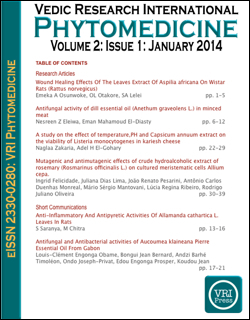
Wound Healing Effects Of The Leaves Extract Of Aspilia africana On Wistar Rats (Rattus norvegicus)
Abstract
Background: The leaves extract of Aspilia Africana was studied for its potency on experimentally induced wound in rats.
Aim : To investigate the effectiveness of Aspilia Africana as a wound healing agent.
Methods: Wounds were inflicted on wistar rats using excision model. 20 male wistar rats (two groups of 10 control and 10 experimental rats) were used for this study. The wounds were processed for histological analysis. Healing was assessed by wound contraction rate, complete day of wound closure and histological analysis of excised tissue.
Result: The wound contraction rates of experimental group on day 6 and 9 were statistically significant (P< 0.05). The mean wound closure for the experimental group was 12.6±1.17cm while that of the control group was 15.0±1.86cm. Concentration of neutrophils and macrophages were intense in experimental group than the control group in tissue samples excised on day 6. Also, the experimental group exhibited more intense concentration of neutrophils, macrophages, fibroblasts and capillaries on day 9 than the control group. It was observed that shorter period of total wound closure and increased inflammatory response corroborate the use of Aspilia Africana in the topical management of wound area with time.
 Conclusion: This study has indicated that extracts of leaves of Aspilia Africana have good potentials for use in wound care and further provide a rationale for the use of the leaves of this plant in wound management.
Keywords
References
Singer AJ, Clark RA . "Cutaneous Wound Healing". N Engl. J. Med. 1999; 341: 738 – 746
http://dx.doi.org/10.1056/NEJM199909023411006
PMid:10471461
Abii TA, Onuoha EN. "The Chemical Constituents of the Leaf of Aspilia africana as a Scientific Backing to its Tradomedical Potentials". Medwell publishing. 2011; 6: 28 – 30
Oliver BEP. "Medicinal plants in Nigeria". Nigerian college of Arts, science and Technology, lagos, Nigeria. 1960.
Hanna MM, Niemetz J."Studies on the Anticoagulant Action of Aspilla Africana".PubMed. Thromb Res. 1987; 47(4): 401 – 407.
http://dx.doi.org/10.1016/0049-3848(87)90455-5
Okokon JE, Nwidu LI, Essiet GA. Evaluation of in-vivo antiplasmodial activity of Aspilia Africana. Inter J Pharm. 2006; 2(3) 348-351.
http://dx.doi.org/10.3923/ijp.2006.348.351
Okoli CO, Akah PA, Okoli SA. Potentials of leaves of Aspilia Africana (Compositae) in wound care. An experimental evaluation. BMC complementary alternative medicine. 2007; 7:24.
http://dx.doi.org/10.1186/1472-6882-7-24
PMid:17623087 PMCid:PMC1940021
Adeniyi BA. and Odufowora RO. "In-Vitro Antimicrobial Properties of Aspilla Africana (Compositae) ". Afr. J. Biomed. Res. 2000; 3:167-170.
Okoli C.O, Akah PA, Nwafor SV, Anisiobi AI, Ibegbunam IN . Anti-inflammatory Activity of Hexane Leaf Extract of Aspilia africana C.D. Adams. J. Ethnopharm., 2006; 109: 219-225.
http://dx.doi.org/10.1016/j.jep.2006.07.037
PMid:16950582
Ubaka M.C, Ukwe V.C, Okoye C.T, Adibe O.M. "Investigation into the Anti-ulcer Activity of Aqueous Leaf Extract of Aspilia africana C.D. Adams". Asian J Med Sci. 2010; 2(2): 40 – 43
Attama AA, Uzor PF, Nnadi CO, Okafor CG. "Evaluation of the Wound Healing Activity of Gel Formulations of Leaf Extract of Aspila africana Fam. Compositae". J. Chem. Pharm. Res. 2011; 3(3):718 – 724.
Billingham RE, Russell PS. Studies on wound healing with special reference to the phenomenon of contracture in experimental wounds in the rabbit's skin. Annals of surg. 1956; 144 (6): 961-981.
http://dx.doi.org/10.1097/00000658-195612000-00005
PMid:13373285 PMCid:PMC1465358
Badoe EA, Archampong EQ, Jaja MOA. Principles and practice of surgery. Ghana publishing corporation. 1994; 51;12.
O' Reilly RA. Drugs used in disorders of coagulation. In: BG Katzung, Editor, Basic and clinical Pharmacology. Appleton and Lange, Connecticut. 1998; 547-561.
Clark RAF . "Cutaneous wound repairs". In physiology, Biochemistry and molecular biology of skin. Goldsmith LA. New York: oxford university press. 1991; 576.
Trabucchi E, Preis-Baruffaldi F, Baratti C, Montorsi W. Topical treatment of experimental skin lesions in rats: macroscopic, microscopic and scanning electron-microscopic evaluation of the healing process. Int. J. Tissue. React., 1986; 8: 533-544.
PMid:2432029
Shukla A, Rasik AM., Dhawan BN. Asiaticoside-induced elevation of antioxidant levels in healing wounds. Phytotherapy. Res., 1999; 13(1): 50-54.
http://dx.doi.org/10.1002/(SICI)1099-1573(199902)13:1<50::AID-PTR368>3.0.CO;2-V
.Oko OOK, Agiang EA, Osim EE, Asuquo OR. Toxicological Evaluation of Aspilia Africana Leaf Extracts in Mice. Am J Pharm and Toxicol, 2011; 6 (3): 96-101.
http://dx.doi.org/10.3844/ajptsp.2011.96.101
DOI: http://dx.doi.org/10.14259%2Fpm.v2i1.59
Refbacks
- There are currently no refbacks.






